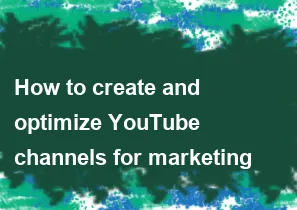How to create and optimize YouTube channels for marketing

Creating and optimizing a YouTube channel for marketing involves several key steps to maximize visibility, engagement, and conversion. Here's a comprehensive guide to help you get started:
1. Define Your Goals:
- Clearly define your marketing goals. Are you looking to increase brand awareness, generate leads, drive sales, or something else?
2. Create a YouTube Account:
- Sign in to YouTube with a Google account.
- Go to YouTube Studio and click on "Create a new channel."
3. Channel Branding:
Profile Picture and Banner:
- Use a high-quality, recognizable profile picture (usually a logo).
- Design an eye-catching channel banner that represents your brand.
Channel Description:
- Write a compelling and concise channel description. Include keywords related to your niche.
Channel Trailer:
- Create a short, engaging trailer introducing your channel and its value proposition for new visitors.
4. Optimize Your Videos:
Keyword Research:
- Identify relevant keywords using tools like Google Keyword Planner or YouTube's search suggestions.
Video Title:
- Craft compelling, keyword-rich titles that encourage clicks.
Video Description:
- Write detailed, keyword-optimized descriptions with links, timestamps, and relevant information.
Tags:
- Use relevant tags to improve discoverability.
Thumbnail:
- Design attention-grabbing thumbnails that accurately represent the video content.
Transcripts and Closed Captions:
- Add transcripts and closed captions to make your videos more accessible and improve search rankings.
5. Consistent Content Schedule:
- Develop a consistent posting schedule to keep your audience engaged.
6. Engage with Your Audience:
- Respond to comments promptly and encourage viewers to like, share, and subscribe.
7. Create Playlists:
- Organize your content into playlists to enhance user experience and increase watch time.
8. Promote Your Videos:
- Share videos on other social media platforms.
- Embed videos on your website or blog.
9. Collaborate with Others:
- Collaborate with other YouTubers or influencers in your niche.
10. Analytics:
- Use YouTube Analytics to track performance and make data-driven decisions.
11. Monetization and Advertising:
- Once eligible, enable monetization options.
- Consider running YouTube ads to reach a broader audience.
12. SEO Best Practices:
- Optimize your videos for search engines by using relevant keywords in titles, descriptions, and tags.
13. Channel Customization:
- Customize your channel layout to enhance visual appeal and usability.
14. Utilize YouTube Features:
- Experiment with features like YouTube Stories, Shorts, and Community posts.
15. Stay Informed:
- Keep up with YouTube's policies, algorithm changes, and best practices.
16. Paid Promotions and Sponsorships:
- Explore paid promotions and sponsorships to expand your reach.
17. Monitor and Adjust:
- Regularly review your analytics and adjust your strategy accordingly.
Remember that building a successful YouTube channel takes time, consistency, and a willingness to adapt to changes in the platform and your audience's preferences.
-
Popular Post
- How to optimize for Google's About This Result feature for local businesses
- How to implement multi-language support in an Express.js application
- How to handle and optimize for changes in mobile search behavior
- How to handle CORS in a Node.js application
- How to use Vue.js with a UI framework (e.g., Vuetify, Element UI)
- How to configure Laravel Telescope for monitoring and profiling API requests
- How to create a command-line tool using the Commander.js library in Node.js
- How to implement code splitting in a React.js application
- How to use the AWS SDK for Node.js to interact with various AWS services
- How to use the Node.js Stream API for efficient data processing
- How to implement a cookie parser middleware in Node.js
- How to implement WebSockets for real-time communication in React
-
Latest Post
- How to implement a dynamic form with dynamic field styling based on user input in Next.js
- How to create a custom hook for handling user interactions with the browser's device motion in Next.js
- How to create a custom hook for handling user interactions with the browser's battery status in Next.js
- How to implement a dynamic form with dynamic field visibility based on user input in Next.js
- How to implement a dynamic form with real-time collaboration features in Next.js
- How to create a custom hook for handling user interactions with the browser's media devices in Next.js
- How to use the useSWRInfinite hook for paginating data with a custom loading indicator in Next.js
- How to create a custom hook for handling user interactions with the browser's network status in Next.js
- How to create a custom hook for handling user interactions with the browser's location in Next.js
- How to implement a dynamic form with multi-language support in Next.js
- How to create a custom hook for handling user interactions with the browser's ambient light sensor in Next.js
- How to use the useHover hook for creating interactive image zoom effects in Next.js